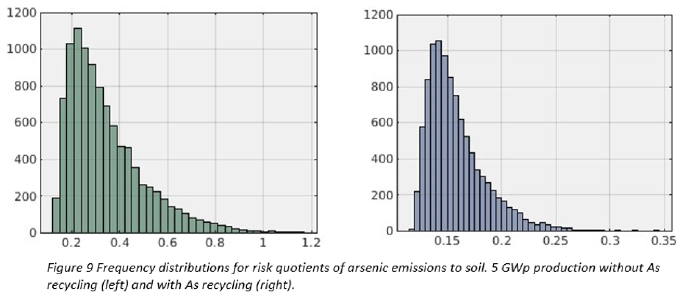Update 2 - Human Health and Ecological Risk Assessment
Description: Leiden University conducted an exploratory assessment of the environmental health and safety risks of the III-V materials used in the SiTaSol technology. The aim of this work was two-fold; on one hand, to make order-of-magnitude estimations of the chemical risks introduced by emissions of III-V materials from a future III-V/Si PV supply chain. On the other hand, we sought to advance methods in the practice of sustainability assessment of emerging technologies. Here we made an important contribution by introducing state-of-the-art probabilistic and global sensitivity analysis methods and coupling them for the first time with the environmental fate model SimpleBox, which is widely used by the scientific community in Europe and around the world.
Our assessment was placed in the context of current social, regulatory, and technological trends in waste management. The main source of potentially toxic releases would be inadequate above-ground disposal of used III-V/Si cells in landfills, even though this practice is expected to happen only to a small extent. The relevant increases in concentrations would occur mostly in soil, while in all scenarios modelled the freshwater ecosystems showed negligible responses. In soil, the mobility of III-V materials is very low, and releases will be diluted in time over hundreds or thousands of years. Tighter regulations for landfill containment and monitoring systems can be expected to dilute these processes further.
In the case of gallium and indium, these elements have much lower reactivity, so the emissions that do occur will have negligible effects. Nevertheless, at large production scales (>5 GWp) the risk may increase to a point that implementation of stricter control measures, particularly around more effective collection of used PV panels and increased recycling of arsenic, may be required. This must be taken in consideration, especially in light of potential future expansion of markets for other arsenic containing electronic waste, such as that from discarded integrated circuits and LED diodes. Nevertheless, a low-emission scenario for the life cycle of future III-V/Si photovoltaics is moving from cautiously optimistic to likely.
We identified four key areas for further research. First, the use of dynamic exposure models rather than steady state models, work which is currently being undertaken by Leiden University and will be incorporated into deliverable 6.5. Second, more detailed modelling of the leaching and leaking behaviour of III-V panel materials in landfills. Third, better understanding of the speciation of arsenic released from III-V materials in a landfill.
Finally, but of perhaps more importance, a more in-depth exploration of where waste management regulations are headed in the European context, and how the established thresholds and controls mechanisms will further limit the emissions that may occur during the life cycle of III-V/Si PV.
